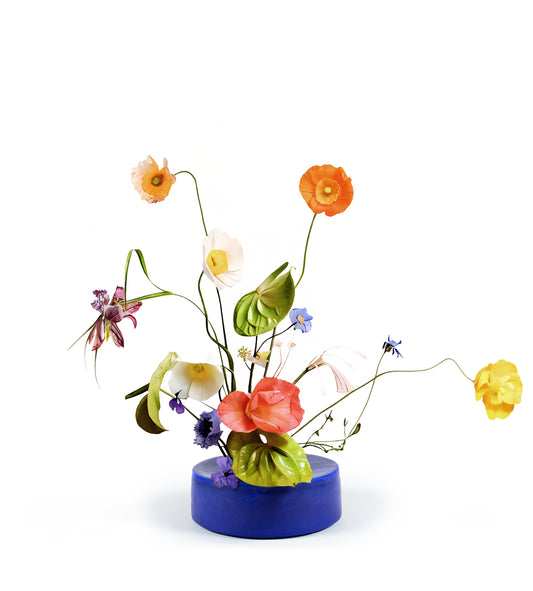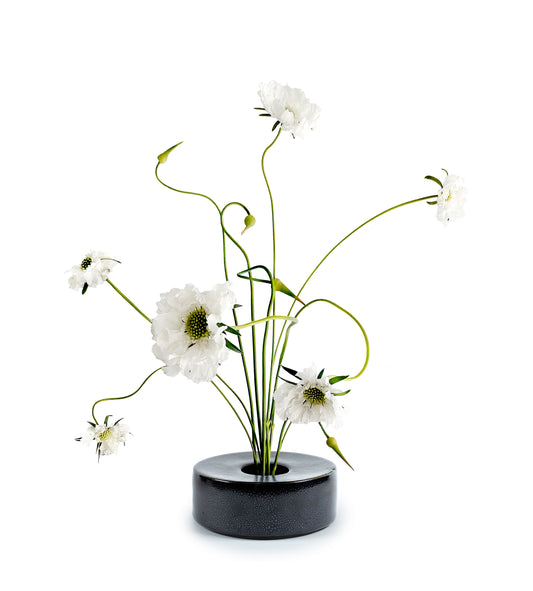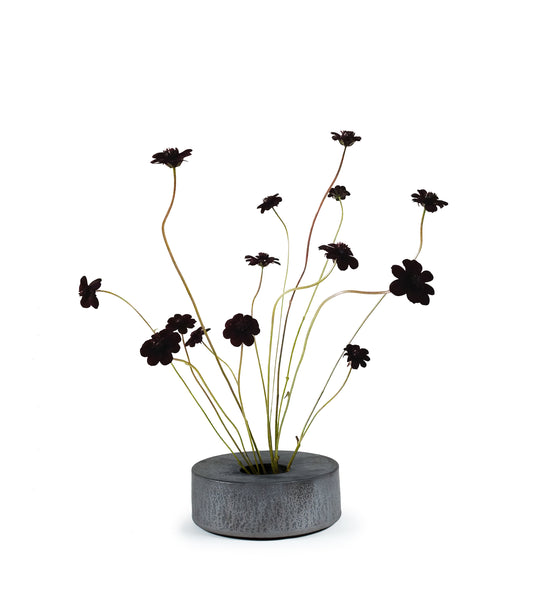Ikebana - the centuries-old Japanese art of floral arrangement - is more than decoration. It’s a practice in balance, space, and stillness. Using only a few stems, a vessel, and a flower frog, Ikebana turns simple flowers into a sculpture.
Whether you’re using a modern handmade ceramic Ikebana vase or a traditional ikebana vase, the process invites you to connect with nature and your own sense of calm focus.
Step 1: Choose the Right Ikebana Vase
The vase anchors your composition. A vase for Ikebana is usually shallow and wide, creating room for negative space and visibility of water - both key elements in Japanese design philosophy.
What to Look for:
- Shape: look for low-profile or sculptural forms that complement minimal stems. The key here is to choose an ikebana vase that puts all of the focus on the flowers.
-
Material: A ceramic ikebana vase that offers grounding textures and weight, preventing top-heavy arrangments.
- Color: Earth tones or muted glazes that frame the flowers without competeing for attention.
Pro Tip: The right vase will feel balanced even before the first stem is placed and allows for effortless arragements. View our Ikebana vases here.
Step 2: Prepare Your Flower Frog (Kenzan)
The kenzan - or flower frog - is a weighted pin holder that supports each stem. It gives structure and freedom at the same time, allowing flowers to stand at purposeful angles.
How to use it:
- Position the kenzan in the bottom of your vase.
- Add just enough water to cover the pins.
- Trim stems at a diagonal and press gently onto the pins.
If you’re using a ceramic Ikebana vase, ensure the base is heavy enough for balance. The kenzan should feel secure even when stems lean at sharp angles.
Step 3: Select Flowers and Branches with Meaning
An Ikebana flower vase celebrates the essence of each material - not excess, but character. Instead of a dense bouquet, choose just a few stems that contrast in shape, height, and texture.
Good Ikebana materials:
- Branches: Willow, pine, or maple for height and structure
- Blooms: Chrysanthemums, irises, tulips, or camellias
- Accents: Ferns, reeds, or seed pods for added interest
Each season carries its own message - spring expresses new beginnings, summer abundance, autumn transience, winter contemplation. Selecting seasonal elements ties your arrangement to time and place.
Step 4: Arrange with Intention and Space
Ikebana arrangements follow the shin–soe–hikae structure, symbolizing heaven, earth, and humanity. This triad creates both visual and spiritual harmony.
- Shin (Heaven): The tallest stem, placed slightly off-center, sets the movement.
- Soe (Earth): The medium stem, angled outward, adds balance.
-
Hikae (Human): The shortest stem connects the composition and creates grounding.
Allow space between each element - in Ikebana, the emptiness is just as meaningful as the form. A good Ikebana arrangement feels like it’s still growing, alive in motion - not fixed in place.
Step 5: Refine, Observe, and Maintain
Once arranged, take a moment to observe. Look from all sides. Notice how light reflects on water, how the stems interact with negative space.
To keep your Ikebana fresh:
- Replace the water daily to prevent bacterial growth.
- Recut stems every few days at an angle.
-
Avoid direct sunlight - indirect light preserves color and structure.
Ikebana teaches impermanence - each arrangement will shift slightly with time, and that change is part of its beauty.
Common Mistakes to Avoid
-
Too many flowers: Clutter disrupts the natural rhythm.
- Flat angles: Vary directions for depth and flow.
-
Ignoring water clarity: Clean water enhances the reflective quality of the design.
Closing Thought
Creating an Ikebana arrangement transforms an ordinary vase of flowers into a meditative act. Whether displayed in a Japanese Ikebana vase or one of Dweller Studio’s handcrafted ceramic Ikebana vases, each piece becomes a dialogue between nature and design - between the seen and the unseen.





